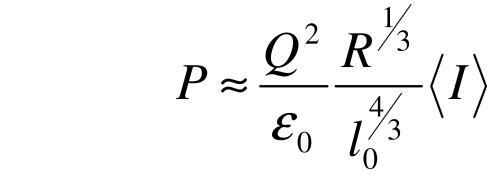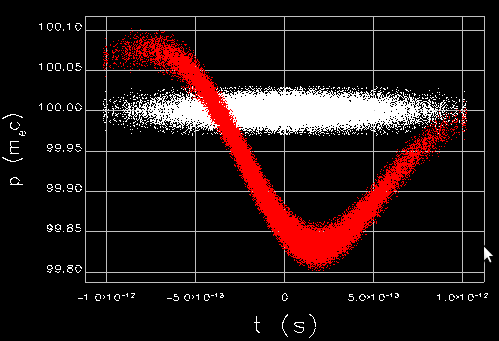bERLinPro
High Current Issues
Since bERLinPro is the technology demonstrator for the future application of the ERLs as a synchrotron radiation facility, achieving high beam current is one of primary goals. The targeted 100 mA average current is challenging. The processes limiting the current are beam instabilities (e.g. transversal multi-bunch beam break-up (BBU)), beam losses due to the beam halo build up. Other high current issues include beam energy losses due to the coherent synchrotron radiation (CSR) and other beam induced so called wake-fields.
Beam Break Up
In the superconducting accelerating cavities the electromagnetic fields might be expressed as sums of transverse magnetic (TM) and transverse electric (TE) modes. For TM modes there is a longitudinal electric field presented and a magnetic field could be everywhere perpendicularly to the longitudinal axis. And for TE modes the situation is conversed with an existing longitudinal magnetic field and with electrical field transverse to it everywhere.
When a charge passes through an accelerating cavity it excites modes and induces fields which provide a retarding force. Some of the modes could be excited quite strong and lead to beam instabilities and finally to a beam loss. One potential weakness of the ERLs is transverse beam breakup instability (BBU), which may severely limit a beam current. The actuality of this problem was recognized in early experiments with the recirculating SRF accelerators at Stanford [1] and Illinois [2], where threshold current of this instability was occurring at few microamperes of the average beam current. In the works of Rand and Smith in [3] dipole high order modes were identified as a driver of this instability. In late of the 80’s the detailed theoretical model and simulation programs had been developed [4, 5]. Nowadays the interest to this problem was renewed. The requirements for more detailed theory and simulation programs [6-8] are given by the needs of high current (~100 mA) ERLs. The mechanism of this instability is explained below. When an electron bunch passes through an accelerating cavity it interacts with dipole modes (e.g. TM110) in the cavity (Fig. 1). First, it exchanges energy with the mode; second, it is deflected by the electro-magnetic field of the mode. After recirculation the deflected bunch interacts with the same mode in the cavity again and transfers energy to it. If the net energy transfer from the beam to the mode is larger than the energy loss due to the mode damping, the beam becomes unstable.
However, it is not only that a beam could be lost, but some of the modes (e.g. quadrupole modes) might lead to a beam degradation. That means the loss of luminosity for a collider or the loss of brightness for a light source. Furthermore, the excited modes dissipate power in the cavity walls that increases the cryogenic load.
[1] Claude M. Lyneis, Michael S. McAshan, Roy E. Rand, H. Alan Schwettman, Todd I. Smith and John P. Turneaure, The Stanford Superconducting Recyclotron, IEEE Transactions on Nuclear Science, Vol. NS-26, No. 3, June 1979.
[2] P.Axel, L.S.Cardman, H.D.Graef, A.O.Hanson, R.A.Hoffswell, D.Jamnik, D.C.Sutton, R.H.Taylor, and L.M.Young, Operating Experience with MUSL-2, IEEE Transactions on Nuclear Science, Vol. NS-26, No. 3, June 1979.
[3] R.E. Rand and T.I. Smith, Beam optical control of beam breakup in a recirculating electron accelerator, Particle accelerators, Vol. 11, pp. 1-13 (1980).
[4] J.J. Bisognano, R.L. Gluckstern, in Proceedings of the 1987 Particle Accelerator Conference, Washington, DC (IEEE Catalog No. 87CH2387-9), pp. 1078-1080.
[5] G.A. Krafft, J.J. Bisognano, in Proceedings of the 1987 Particle Accelerator Conference, Washington, DC (IEEE Catalog No. 87CH2387-9), pp. 1356-1358.
[6] G.H. Hoffstaetter, I.V. Bazarov, Beam-breakup instability theory for the energy recovery linacs, Phys. Rev. ST AB 7, 054401 (2004).
[7] E. Pozdeyev, et al., Multipass beam breakup in energy recovery linacs, NIM A 557 (2006) 176-188.
[8] N.A. Vinokurov et al., Proc. of SPIE Vol. 2988, p. 221 (1997).
References:
Y. Petenev et al.: Modelling of the Beam Break Up Instability for BERLinPro, IPAC2011
Coherent Synchrotron Radiation (CSR) and wake fields
One of the important features of ERL-based light sources is the possibility to produce short electron bunches with the length of down to 3 micron (or duration of 10 fs). However, so short bunches radiate coherently at the wavelengths above approximately the bunch length. The power of coherent radiation of such a beam can be very high, if the average current is high:
Here Q is the bunch charge, R is the bending radius in dipole magnets, l0 is the bunch length, the power from all magnets (full turn of 360°) is taken into account, numerical coefficient can appear depending on the longitudinal electron distribution in the bunch . Estimations show, e.g. for a 100 fs full charge (77 pC) bunches with full filling (1.3 GHz bunch repetition rate) in bERLinPro average CSR power would be about 30 kW, that is a serious threat for the accelerator components and vacuum system.
Other beam-induced fields in an accelerator are e.g. the higher oscillating modes in the accelerating cavities, fields of the so called “mirror” charges and currents in the vacuum chamber walls, etc. These fields lead to the beam energy or quality losses too and should be avoided. Careful modelling of the CSR and other beam-induced electromagnetic fields is important for the understanding of the limits of the achievable bunch parameters in the future accelerators.
References
[1] E.L. Saldin, E.A. Schneidmiller, M.V. Yurkov, “On the coherent radiation of an electron bunch moving in an arc of a circle”, Nuc. Instrum. Methods Phys. Res. A, 398, pp. 373–-394, (1997).
[2] S. Heifets and G. Stupakov, Beam instability and microbunching due to coherent synchrotron radiation, SLAC-PUB-8767, 1/2001



